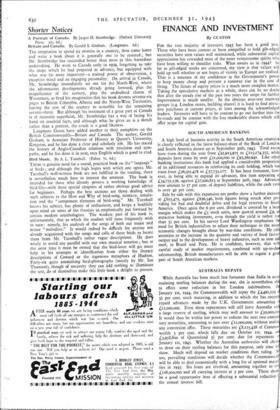FINANCE AND INVESTMENT
By CUSTOS
FOR the vast majority of investors 1943 has been a good year, Those who have been content or been compelled to hold gilt-edged securities have seen values well maintained, while substantial capital appreciation has rewarded most of the more venturesome spirits who have been willing to shoulder risks. What awaits us in 1944? Sr far as gilt-edged stocks are concerned, my view is that values will hold up well whether or not hopes of victory in Europe are realised. That is a measure of my confidence in the Government's power to keep money cheap and prevent a runaway rise in the cost of living. The future of equity prices is a much more complex matter. Taking the speculative markets as a whole, there can be no doubt that after the steady rise of the past two years the scope for furthet improvement is much smaller. In the obvious post-war recovery groups (e.g. London stores, building shares) it is hard to find attrac- tive purchases at current prices, at least among the acknowledged leaders. Investors will have to be content to go out further into the by-roads and be content with the less marketable shares which still offer scope for capital gain.
SOUTH AMERICAN BANKING A high level of business activity in the South American countries is clearly reflected in the latest balance-sheet of the .Bank of London and South America drawn up at September 30th, 1943. Total assets have risen during the year from £92,913,975 to £115,174,352, while deposits have risen by over £21,000,000 to £93,360,941. Like other banking institutions this bank had applied a considerable proportion of its additional resources in reinforcing its cash holding, which has risen from £26,301,478 to £37,735,177. It has been fortunate, how- ever, in being able to expand its advances, this item appearing a £34,731,536, against £27,000,813 at September 30th, 1942. Advan now amount to 37 per cent. of deposit liabilities, while the cash rat' is over 4o per cent.
Side by side with this expansion net profits show a further increa at £655,475, against £636,546, both figures being struck after p viding for bad and doubtful debts and for legal reserves in Sout America. Once again the 6 per cent, dividend is covered by a larg margin which makes the £5 stock units, now quoted around £9, attractive banking investment, even though the yield is rather les than 3} per cent. In his survey Lord Wardington emphasises di need for British industrialists to adjust their technique to the man economic changes brought about by war-time conditions. He call attention to the increase in the quantity and variety of local factor output and to the development of heavy industries, such as iron steel, in Brazil and Peru. He is confident, however, that wi careful study of market requirements, combined with up-to-da salesmanship, British manufacturers will be able to regain a gres part of South American markets.
AUSTRALIA REPAYS
While Australia has been much less fortunate than India in accu mutating sterling balances during the war, she is nevertheless abl to effect some reduction in her London indebtedness. 0 January ist, 1944, the Commonwealth will repay the £4,491,129 31. per cent. stock maturing, in addition to which she has recentl repaid advances made by the U.K. Government amounting f £12,000,000. Even these repayments will still leave Australia wi a large reserve of sterling, which may well amount to £50,000, Of. It would thus be within her power to redeem the next two compul sory maturities, amounting to just over £12,000,000, without maki any conversion offer. These maturities are £8,125,428 of Common wealth 3 per cent. which falls due on October ist, 5944, a £3,958,800 of Queensland 3% per cent. due for repayment 0 January ist, 1945. Whether the Australian authorities will choo to draw on their sterling balances for this purpose, only time WI show. Much will depend on market conditions then ruling. too, prevailing conditions will decide whether the Commonweal will be able to deal economically with a long list of optional matun ties in 1945. Six loans are involved, amounting together to ov £108,000,000 and all carrying interest at 5 per cent. There shoo be a good opportunity here of effecting a substantial reduction the annual interest bill. .111






























 Previous page
Previous page